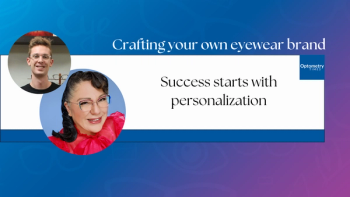
Creating culturally competent patient care
Having an understanding of cultural norms can help identify and mitigate many of the cultural barriers that negatively impact quality and perpetuate disparities in health and health care, especially among racial and ethnic populations who frequently are at increased risk for certain ocular morbidities like glaucoma and diabetic retinopathy.
In the 4th century B.C., Hippocrates understood that illness has-in addition to its biomedical context-an environmental, social, and behavioral context.1
Today, we understand that access to vision and eye care can be influenced by a variety of non-biomedical factors, including health literacy, language, race and ethnicity, patient perceptions, trust, and cultural values and beliefs.2
Both patients and optometrists are more likely today to bring to the clinical encounter a complex cross-cultural array of attitudes, customs, preferences, assumptions, expectations, practices, and fears that help decode experiences, form perspectives, influence decisions, and drive behavior.
The importance of understanding culture
Having an understanding of cultural norms can help identify and mitigate many of the cultural barriers that negatively impact quality and perpetuate disparities in health and health care, especially among racial and ethnic populations who frequently are at increased risk for certain ocular morbidities like glaucoma and diabetic retinopathy.
With the racial and ethnic population in the U.S. expected to increase from 37 percent to 57 percent by the year 2060, the need for cultural competency as a component of quality health care becomes more compelling each day.3
Former U.S. Surgeon General Antonia Novello commented at the recent annual meeting of the American Public Health Association that, “prevention cannot work unless you understand the culture of the people.”4
Related:
Each of us represents a blend of cultures that are conditioned by the collective and diverse experiences of our age, race, ethnicity, gender, sexual orientation, education, religion, socioeconomic status, geographic residence, and even our occupation or profession.
Cultural diversity can introduce an unexpected dimension into the traditional biomedical paradigm of ophthalmic care. Conflicts can arise and interpersonal relationships can suffer when cultural-based dynamics clash. Such conflicts in health care can adversely affect communication, understanding, compliance, satisfaction, and ultimately the opportunity to achieve the most optimal health outcomes.
Accepting the cultural realities of your practice
Optometrists are educated and trained in what we consider to be the traditional constructs of health and illness.
However, many of our patients today may subscribe to a different “traditional” construct that defines their needs, informs their perceptions of health and illness, and establishes their attitudes toward seeking and receiving health care. What is considered traditional or usual in one culture may be considered non-traditional or alternative in another culture.
Our biomedical construct may associate a certain morbidity to a biomedical etiology-such as a metabolic dysfunction or bacterial infection-whereas a cultural construct may attribute the same illness to spiritual imbalance, malevolent spirits, susto (loss of soul), mal de ojo (evil eye), punishment, the wind, fatalism, or God’s will.
Related:
Similarly, the reliance on traditional practices-like healing rituals, prayer, meditation, herbs, massage, coining, and cupping-may be more of a cultural norm than the willing acceptance of some biomedical therapies, such as the long-term use of medications for chronic conditions like open-angle glaucoma. Cultural beliefs, like the belief that talking about a specific illness will cause the illness to occur, could present roadblocks to effective and efficient patient-doctor communication.
Likewise, underestimating the role of the extended family in discussions, decision making, and therapeutic care (familismo) could create unforeseen challenges, such as reconciling patient privacy with the decision-making traditions of family-centered care.
It is critically important that optometrists be non-judgmental in accepting the cultural realities of their practices-that the diversity of perceptions and beliefs about health and illness are potential quality-of-care issues that can impact both the delivery of services and their clinical outcomes.
Non–English-speaking patients
With 21 percent of the U.S. population aged 5 years and over currently speaking a language other than English at home, linguistic competence becomes an integral aspect of the cultural competence paradigm.5 The enhanced National Standards on Culturally and Linguistically Appropriate Services (CLAS), published by the U.S. Office of Minority Health, target cultural and linguistic barriers to healthcare delivery.
For example, the standards call for competent language assistance and recommend against the use of untrained persons and/or minors as ad hoc interpreters for patients who have limited English proficiency and/or other communication needs.
The comprehensive CLAS guidelines also call for the use of multilingual print and multimedia materials and signage that would be easily understood by patients who have limited English ability.
Related:
Responding to a congressional directive, the National Eye Institute launched the National Eye Health Education Program, which provides culturally and linguistically appropriate, evidence-based materials for eyecare professionals to use and share with diverse patients.
Optometrists can use the materials to help address language barriers in caring for patients and as a sign of recognition and respect for their cultural backgrounds. (Available at:
More resources
The concept of cultural and linguistic competency in health care is not new. In 1996 the Society of Teachers of Family Medicine advanced the hypothesis that “the delivery of high-quality primary health care that is meaningful, acceptable, accessible, effective, and cost efficient requires a deeper understanding of the sociocultural background of patients, their families, and the environments in which they live.”6
In setting goals for the “preferred future” of the optometric profession, the 2007 Optometry 2020 Summit called for optometrists and their staff to have the knowledge, skills, and attitude to serve patients of different ethnicities, native languages, age, gender, religions, and cultural backgrounds and to be linguistically competent by providing care in multiple languages and/or providing interpretation services.7
In 2008, the Association of Schools and Colleges of Optometry (ASCO) approved the ASCO Guidelines for Culturally Competent Eye and Vision Care to assist optometric institutions with preparing clinicians to understand and respect diverse values, beliefs, and expectations in addressing the vision and eyecare needs of a multicultural community.
In 2012, Transitions Optical introduced the Transitions Cultural Connections initiative with a complimentary package of multicultural resources, which includes the recently released consensus paper from its hosted roundtable discussion on the topic of improving the eye health of culturally diverse populations. (Available at:
The cultural competency continuum
There is no cookbook or shortcut to cultural competence. It is a continuous and progressive process.
The cultural competence continuum involves a series of steps from “cultural destructiveness” and “cultural incapacity” through “cultural blindness” and “cultural pre-competence” to “cultural competence” and “cultural proficiency.”8
More simplistically, the continuum can be viewed as a progression from “unconscious incompetence” in which there is an absence of awareness of cultural differences to “unconscious competence” and the ability to provide culturally appropriate care spontaneously.9
Culturally competent practitioners are not expected to understand and respond to every cultural aspect of every patient, but simply to challenge their own cultural assumptions and preconceptions while embracing a patient-centered culture of care.
The amalgam of knowledge, skills, and attitudes that define cultural competence encompass both the clinician’s understanding of and respect for individual patient values, beliefs, and needs and the clinician’s awareness of her own values, assumptions, and needs in adapting care that is clinically, culturally, and linguistically appropriate.10
It is like looking at patients through their cultural lens and integrating their perspectives into their personalized care.
The advantages of cultural competency
According to a recent survey, 95 percent of eyecare professionals believe that a good understanding of a patient’s cultural background is constructive to a better patient experience.11 Cultural competence:
• Increases patient-doctor communication and flow of diagnostic and therapeutic information
• Enhances interpersonal understanding and trust
• Facilitates greater access to and timely use of appropriate healthcare services
• Creates opportunities for a more positive understanding of and compliance with both traditional biomedical practices and traditional cultural practices
Cultural competency improves the quality of the healthcare experience. Conversely, culturally-blind care can lead to less than optimal and possibly negative outcomes among diverse patient populations.
The ultimate goal of optometric practice is to provide quality healthcare practices and achieve optimal eye and vision health for our patients. While we provide the best clinical care with the intention for quality in all cases, the impact of our unconscious actions may generate unintended consequences.
Cultural competence is a current day necessity for a quality response to traditional healthcare practices and to fostering patient-centered climates of respect and trust for the values, needs, and expectations of both the patient and the doctor.
References:
1. Lasker RD. Medicine & Public Health: The Power of Collaboration. Committee on Medicine & Public Health. New York, NY: The New York Academy of Medicine, 1997.
2. ORC/Macro. Identification of variables that influence access to eye care: final report. National Eye Institute, National Institutes of Health. July 28, 2005.
3. U.S. Census Bureau. U.S. Census Bureau projections show a slower growing, older, more diverse nation a half century from now. Available at: http://www.census.gov/newsroom/releases/archives/population/cb12-243.html. Accessed: 11/25/2014
4. American Public Health Association. Public health giants among us. Available at: http://www.aphaannualmeeting.blogspot.com/2014/11/public-health-giants-among-us.html. Accessed: 11/25/2014
4. Ryan C. Language use in the United States: 2011. U.S. Census Bureau, August 2013. Available at: http://www.census.gov/prod/2013pubs/acs-22.pdf. Accessed: 11/25/2014.
5. Like RC, Steiner RP, Rubel AJ. STFM core curriculum guidelines: recommended core curriculum guidelines on culturally sensitive and competent health care. Fam Med. 1996 Apr;28(4):291-7.
6. American Optometric Association. Optometry 2020 Summit. 2007.
7. Cross TL, Bazron BJ, Dennis KW, et al. Towards a Culturally Competent System of Care: A Monograph on Effective Services for Minority Children Who Are Severely Emotionally Disturbed. Washington, DC: Georgetown University Child Development Center, 1989.
8. Campinha-Bacote, J. Many faces: addressing diversity in health care. Online J Issues Nurs. 2003;8(1):3.
9. Mutha S, Allen C, Welch M. Toward Culturally Competent Care: A Toolbox for Teaching Communication Strategies. San Francisco, CA: Center for the Health Professions, University of California, San Francisco, 2002.
10 Online survey among a nationally representative sample of 241 eye care professionals conducted by Jobson Optical Research on behalf of Transitions Optical, Inc. March 2014.
Newsletter
Want more insights like this? Subscribe to Optometry Times and get clinical pearls and practice tips delivered straight to your inbox.
















































.png)


